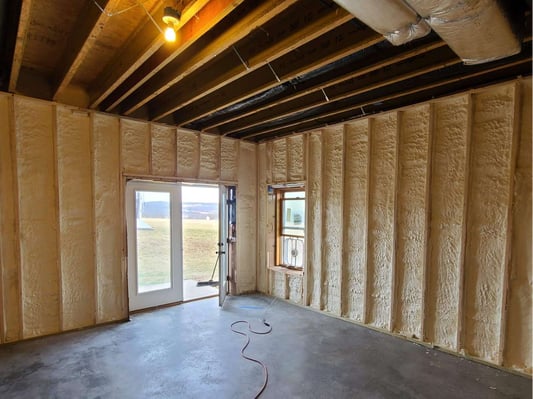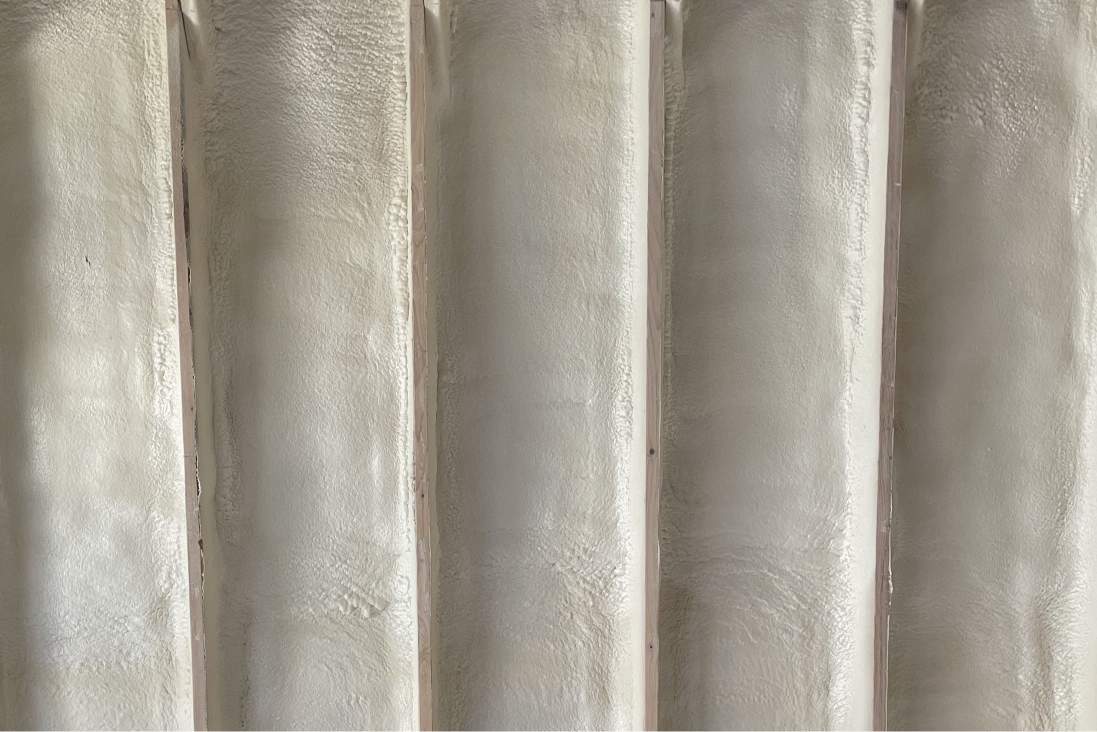
Closed cell insulation provides superior protection against extreme weather by creating an impermeable barrier that blocks air, moisture, and temperature transfer. This dense foam structure delivers R-values of 6-7 per inch while simultaneously acting as a structural reinforcement, vapor barrier, and air seal. Unlike traditional insulation materials, closed cell foam maintains its protective properties during hurricanes, blizzards, floods, and extreme temperature swings.
The material’s closed cell structure prevents water absorption and air infiltration that compromise other insulation types during severe weather events. Professional installations can withstand wind pressures exceeding 200 mph and water submersion for extended periods. This comprehensive protection reduces energy costs by 30-50% while preventing moisture-related damage that leads to mold, rot, and structural deterioration.
Weather Protection Mechanisms
Closed cell insulation operates through multiple protective mechanisms that work together to shield homes from extreme weather conditions. Understanding these protection methods helps explain why this material outperforms traditional insulation during severe weather events.
Air Infiltration Control
The foam’s continuous structure eliminates air gaps that allow weather penetration. Each closed cell acts as an individual barrier, creating layers of protection against wind-driven rain and temperature transfer. This air-tight seal reduces heating and cooling loads during extreme temperature events.
Key air sealing benefits:
- Blocks wind-driven moisture during storms
- Prevents heat loss during cold snaps
- Eliminates drafts that increase energy consumption
- Maintains consistent indoor temperatures during weather extremes
Moisture Barrier Properties
Closed cell foam absorbs less than 2% of its volume in water, making it nearly waterproof. This property prevents moisture accumulation that damages traditional insulation materials. The material maintains its insulating value even when exposed to flooding or prolonged moisture exposure.
Bonus Tip: Install closed cell foam at least 2 inches thick in flood-prone areas to maximize water resistance and structural benefits.
Technical Performance Specifications
Understanding the technical properties of closed cell insulation helps explain its superior weather protection capabilities compared to other insulation materials.
| Property | Closed Cell Foam | Open Cell Foam | Fiberglass | Cellulose |
| R-Value per inch | 6.0-7.0 | 3.5-4.0 | 2.2-2.7 | 3.2-3.8 |
| Air Permeability | <0.02 L/s·m² | 1.5-4.0 L/s·m² | High | High |
| Water Absorption | <2% | 15-20% | 30%+ | 5-20% |
| Vapor Permeance | 0.8-3.0 perms | 15+ perms | High | Variable |
| Compressive Strength | 25-40 psi | 1-2 psi | Minimal | Minimal |
| Operating Temperature | -100°F to 250°F | 0°F to 180°F | -50°F to 180°F | -20°F to 180°F |
Extreme Weather Applications
Different weather conditions require specific protective properties that closed cell insulation delivers through its unique cellular structure and chemical composition.
Hurricane and Wind Resistance
Closed cell foam bonds directly to structural elements, creating composite strength that resists wind uplift and lateral forces. The material has withstood Category 5 hurricane conditions without failure when properly installed. This structural enhancement prevents roof and wall system separation during extreme wind events.
Wind resistance advantages:
- Bonds to framing members for structural reinforcement
- Resists wind uplift forces on roof systems
- Prevents air pressure differentials that cause building failure
- Maintains integrity during debris impact
Flood Protection Capabilities
The material’s closed cell structure prevents water absorption that destroys traditional insulation materials. Closed cell foam can remain submerged for weeks without losing insulating properties or structural integrity. This flood resistance prevents costly insulation replacement after water events.
Extreme Temperature Performance
Closed cell foam maintains its protective properties across temperature ranges from -100°F to 250°F. This stability ensures consistent protection during arctic freezes, desert heat waves, and rapid temperature changes that stress building envelopes.
Structural Enhancement Benefits
Beyond insulation, closed cell foam provides structural benefits that improve overall building resilience during extreme weather events. These properties work together to create a more robust building envelope.
Load-Bearing Capacity
The material adds compressive strength to wall and roof assemblies, helping distribute loads during snow events and wind conditions. Studies show that properly installed closed cell foam can increase wall assembly strength by 75-100%. This enhancement reduces structural stress during extreme weather loading.
Seismic Performance
Closed cell foam’s flexibility and adhesion properties help buildings respond to seismic forces without cracking or separation. The material maintains its bond to structural elements during ground movement, preserving the building envelope’s integrity.
Bonus Tip: Apply closed cell foam in 2-inch lifts for optimal adhesion and structural enhancement properties.
Energy Efficiency During Weather Extremes
Extreme weather events test insulation systems beyond normal operating conditions. Closed cell foam maintains energy efficiency when traditional materials fail, reducing utility costs during peak demand periods.
Temperature Stability
The material’s high R-value and air sealing properties maintain consistent indoor temperatures during temperature extremes. This stability reduces HVAC system stress and prevents equipment failure during peak demand periods. Energy savings increase significantly during extreme weather events when other insulation systems lose effectiveness.
Humidity Control
Closed cell foam prevents moisture infiltration that creates humidity problems during storms and temperature swings. This moisture control maintains indoor air quality and prevents condensation issues that damage building materials and reduce insulation effectiveness.
Market Data and Performance Statistics
The extreme weather insulation market grows at 12% annually, driven by increasing frequency of severe weather events and building code updates. Insurance companies report 60% fewer weather-related claims for homes with closed cell insulation systems compared to traditional insulation materials.
Recent studies indicate that homes with closed cell insulation experience 40% less structural damage during extreme weather events. This data supports growing adoption in hurricane-prone regions and areas with severe winter conditions.
Installation Considerations for Weather Protection
Proper installation techniques maximize closed cell insulation’s weather protection benefits. These factors affect both immediate performance and long-term durability during extreme conditions.
Application Thickness Requirements
Minimum thickness recommendations:
- Hurricane zones: 3-4 inches for maximum wind resistance
- Flood-prone areas: 2-3 inches for water protection
- Extreme cold regions: 4-6 inches for thermal protection
- High-humidity climates: 2 inches minimum for vapor control
Environmental Conditions
Installation requires specific temperature and humidity conditions for optimal performance. Apply foam when temperatures range between 60-80°F and humidity stays below 85%. These conditions ensure proper chemical reaction and cell structure formation.
Things to Consider Before Making a Decision
Several factors influence the effectiveness of closed cell insulation for extreme weather protection. These considerations affect both installation success and long-term performance.
Climate Zone Requirements
Different climate zones present specific challenges that affect insulation selection and installation methods. Hurricane zones require maximum structural enhancement, while cold climates need superior thermal protection. Mixed climates benefit from balanced moisture and thermal control properties.
Building Design Factors
Structural design affects closed cell foam performance during extreme weather. Complex roof lines and wall geometries require careful installation planning to maintain continuous protection. Building orientation and exposure to prevailing weather patterns influence application strategies.
Code Compliance Issues
Building codes increasingly recognize closed cell foam’s structural benefits, allowing reduced framing requirements in some applications. However, fire rating requirements may mandate protective barriers or specialized formulations. Verify local code requirements before installation.
Cost-Benefit Analysis Factors: • Initial installation cost versus long-term energy savings • Insurance premium reductions for enhanced weather protection • Reduced maintenance costs from moisture damage prevention • Increased property value from superior building envelope performance
Common Questions About Weather Protection
How does closed cell foam perform in fires?
Most closed cell foams include fire retardant additives that slow flame spread and reduce smoke production. However, building codes typically require thermal barriers like drywall for fire safety compliance.
Can closed cell foam prevent all weather damage?
While closed cell foam significantly reduces weather-related damage, it works as part of a complete building envelope system. Proper installation and integration with other building components maximize protection effectiveness.
Does closed cell foam work in all climate zones?
Yes, closed cell foam performs effectively across all climate zones when properly specified and installed. Different formulations optimize performance for specific temperature and humidity ranges.
How long does weather protection last?
Quality closed cell foam installations maintain their protective properties for 30+ years when properly installed. The material doesn’t settle, shift, or degrade like traditional insulation materials.
Closed Cell Weather Protection FAQ
Q: Does closed cell insulation prevent ice dams? A: Yes, closed cell foam’s air sealing properties prevent warm air leakage that causes ice dam formation. The continuous barrier maintains consistent roof temperatures that prevent freeze-thaw cycles.
Q: Can closed cell foam withstand tornado conditions? A: Properly installed closed cell foam has survived EF4 tornado conditions by strengthening wall assemblies and preventing air pressure differentials that cause structural failure.
Q: How does closed cell foam compare to traditional vapor barriers? A: Closed cell foam acts as both insulation and vapor barrier, eliminating the need for separate plastic sheeting. This integrated approach prevents installation gaps that compromise protection.
Q: Will closed cell foam crack during extreme temperature changes? A: Quality closed cell foam remains flexible across extreme temperature ranges, preventing cracking that occurs with rigid insulation materials. The material expands and contracts with structural movement.
Q: Does closed cell foam require maintenance after extreme weather? A: Closed cell foam requires minimal maintenance after weather events. Visual inspection ensures no physical damage occurred, but the material typically maintains its protective properties without intervention.
Make the Right Decision
Closed cell insulation provides comprehensive protection against extreme weather through superior air sealing, moisture resistance, and structural enhancement properties. The material’s performance during severe weather events significantly exceeds traditional insulation materials, making it valuable for homes in challenging climates.
Evaluate your specific weather risks, building design, and long-term protection needs when considering closed cell insulation. Work with experienced installers who understand proper application techniques for your climate zone. Consider the total cost of ownership, including energy savings, reduced maintenance, and potential insurance benefits when making your decision.
D&D Insulation LLC
Phone: (903) 389-5705
Email: [email protected]
Reviewer
Reviewer: Henry Turner has 9 years of experience in spray foam insulation. He reviewed this article and helped shape it into a clear guide for companies working to build trust in their local market.

